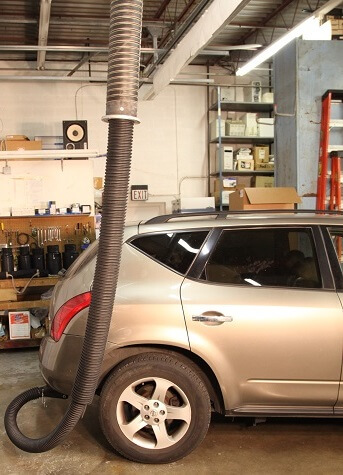While often unnoticed, exhaust hoses can become damaged or fail by a number of things including installation practices, assembly processes, maintenance, inspections, components, or usage. An exhaust hose has a lifespan of at least 10 years, to ensure you get the most usage, implement these seven practices.
Essential Maintenance Practices
1. Select the correct size
Proper sizing is crucial for preventing overheating and ensuring optimal hose performance. A hose with too small an I.D. causes excessive friction, raising the temperature and leading to brittleness, cracks, and reduced flexibility. Similarly, hoses that are too short won't expand or contract properly, stressing the fittings and reinforcement.
Excessive heat can also cause build-up static electricity, leading to potential safety risks in the workspace.
Suitable I.D. sizes for general applications are:
2" - Small cars and motorcycles
|
4" - Large gas cars/ gas or light diesel
|
2.5" - Average size cars
|
5" - Large gas or diesel trucks
|
3 and 3.5" - Average size gas cars/ light trucks
|
6" - Large diesel trucks
|
2. Conduct regular inspections
Inspect hoses frequently for leaks, kinks, abrasions, or tears. Early detection helps prevent failures and ensures that exhaust fumes don’t re-enter the work area, protecting technicians from harmful exposure.
3. Store hoses properly
Store hoses in a cool, dark place to prevent damage from heat, direct sunlight, or humidity. Avoid storing hoses near electrical equipment or in areas prone to high temperatures, as these conditions can weaken the material over time.
4. Inspect exhaust hose components
Check the fittings regularly for leaks, corrosion, or looseness. Any signs of wear should be addressed immediately to prevent hose damage and system failure.
5. Understand the limits
Every exhaust hose comes with specific PSI, fluid compatibility, and temperature limits. Exceeding these limits can cause damage like tearing, swelling, or even bursting. Make sure to stay within the hose’s specifications to avoid costly repairs and downtime.
6. Natural installation
When installing hoses, allow them to bend and twist naturally without forcing sharp angles. This reduces stress on the hose and helps maintain its flexibility, ultimately prolonging its lifespan.
7. Crushproof or wire reinforced?
Choose the right type of hose for your application. Wire-reinforced hoses are ideal for hose reel applications but should never be left on the floor, as they can be crushed when stepped on or run over.
Crushproof hoses, on the other hand, are perfect for floor applications as they retain their shape even when stepped on or driven over but are not suitable for reel applications due to their flexibility.
Properly selecting and maintaining your garage exhaust hose is vital to ensure the safety and efficiency of your vehicle exhaust removal system. If you need assistance in choosing the right hose or components for your garage, the Crushproof-Hose team is here to help. We can advise on hose temperature ratings, diameter, length, and tailpipe adapters that suit your specific application. Contact our experts today for tailored solutions and advice.
You may also like:
• Why Are Crushproof Hoses Better?
• Choose The Right Exhaust Hose in 5 Steps
• Choosing a Tailpipe Adapter

 WARNING: Vehicle Exhaust is extremely dangerous and potentially deadly. We always recommend that any system be properly engineered to meet the specifications of your application. If you are using our Crushproof system, we recommend that you use it with a fan and as an intermittent repair solution only, not to be run for long periods of time. This hose is to be used only with naturally aspirated 4 cycle engines running at an idle and under no load. We recommend keeping any run of hose as short as possible preferably 11' or under and sized to include ambient air to cool the exhaust temperatures. This hose is designed to handle frequent temperatures up to 400° and intermittent temperatures to 600°. When using Crushproof hose for the first time, watch closely to verify that the exhaust is exiting the building as designed. IF YOU SEE ANY EXHAUST COMING BACK INTO THE SPACE, THE HOSE IS NOT BEING USED PROPERLY. TURN THE VEHICLE OFF IMMEDIATELY AND CALL OUR EXPERTS.
WARNING: Vehicle Exhaust is extremely dangerous and potentially deadly. We always recommend that any system be properly engineered to meet the specifications of your application. If you are using our Crushproof system, we recommend that you use it with a fan and as an intermittent repair solution only, not to be run for long periods of time. This hose is to be used only with naturally aspirated 4 cycle engines running at an idle and under no load. We recommend keeping any run of hose as short as possible preferably 11' or under and sized to include ambient air to cool the exhaust temperatures. This hose is designed to handle frequent temperatures up to 400° and intermittent temperatures to 600°. When using Crushproof hose for the first time, watch closely to verify that the exhaust is exiting the building as designed. IF YOU SEE ANY EXHAUST COMING BACK INTO THE SPACE, THE HOSE IS NOT BEING USED PROPERLY. TURN THE VEHICLE OFF IMMEDIATELY AND CALL OUR EXPERTS.